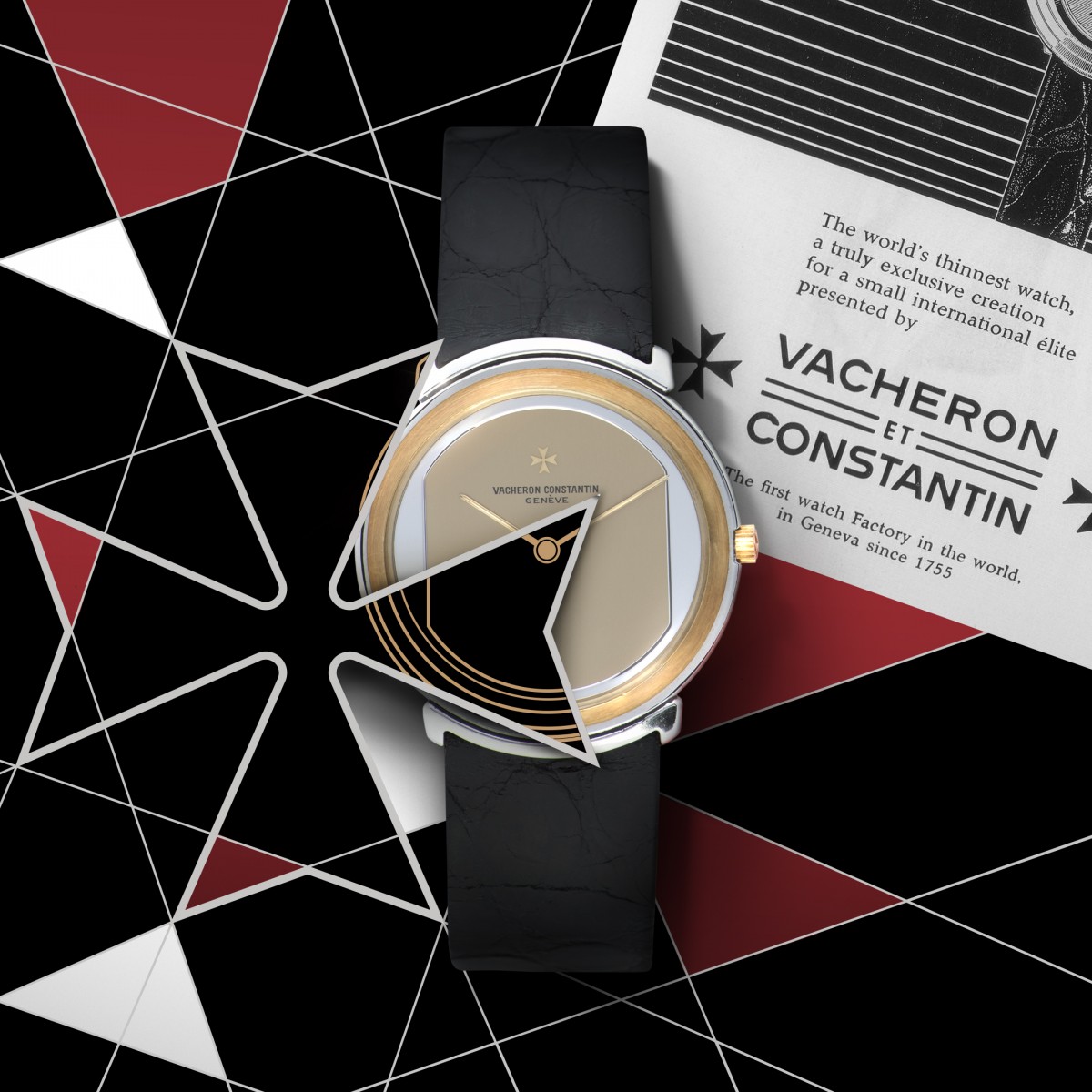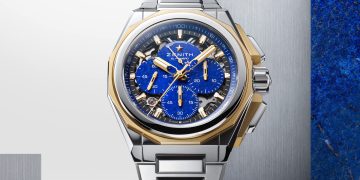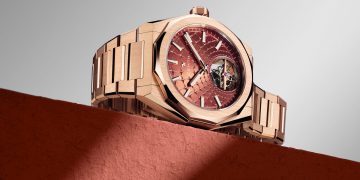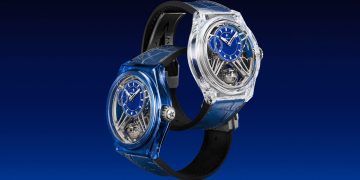Source: Images and content by Vacheron Constantin
http://content.presspage.com/uploads/1999/d2de0b85-9dfe-477d-bbad-637b63f1f057/500_less039ential-heritage-visual-kit5-1-1-1.jpg?10000
- Vacheron Constantin watches cultivate elegance as an art form whose refined aesthetics adorn the most complex mechanical components.
- Drawing on a graphic vocabulary pared down to essentials, the Maison has throughout its history created models embodying impressive horological virtuosity, as shown by this exhibition held from 1 – 11 June 2023 in Vacheron Constantin Pavilion Kuala Lumpur Boutique, Malaysia
- Chosen from the nearly 1,600 timepieces composing Vacheron Constantin’s private collection, these watches bear witness to a heritage characterised by purity of form.
Carefully calculated proportions and the pursuit harmony are never better expressed than through formal purity and clear, perfectly intelligible lines. Applied to watchmaking and its complex mechanical imperatives, this aesthetic quest specific to Vacheron Constantin becomes a sophistication resolutely focused on essentials. Within the Maison, this minimalist approach to watch design has translated into natural elegance. Technically, this is expressed through rare mastery of ultra-thin movements, while attention to detail, finely balanced materials and intelligent composition endow Vacheron Constantin creations with a restrained yet visually striking appearance.
The very concept of elegance is one of the major characteristics of watchmaking as practiced by Vacheron Constantin. Cultivated as an art form, this elegance asserts itself in a natural manner that is almost self-evident. While the Maison’s timepieces exude a subtle and immediately eye-catching charm, nothing is left to chance. This search for watchmaking purity, this quest for essentials in the watch exteriors housing complex mechanisms, stems from a skilful alchemy in which form and function must be in perfect osmosis.
This approach to watch design is unmistakably inspired by two artistic movements that made their mark on the early 20th century. Founded in Weimar in 1919 by the architect Walter Gropius, Bauhaus exerted a considerable influence on the world of arts and crafts, aiming to lay the foundations for a new form of social life. A fertile breeding ground for new experiments, Bauhaus sought to unite technique and aesthetics, fine arts and industry in a quest for simplicity and durability dictated by the functionalism of objects. The scrolling volutes of Art Nouveau thus gave way to pure shapes, with clean-cut lines suited to the newly industrialised conditions of production. From the 1920s onwards, such Art Nouveau-style embellishments were also succeeded by the concern for order and symmetry sought by Art Deco, whose rigorous geometrical display spelled a return to classical conventions.
A new aesthetic
Watchmaking, which aimed to create instruments for everyday life, could not escape this stylistic momentum focused on essentials, strongly fostered by the democratisation of beauty. This was especially so given that the need for functional watchmaking and thus for instrument-watches with “photographic” dials was becoming more and more pressing in the pioneering age of aviation and exploration. The structure and function of the watch thus gave rise to a new aesthetic whose codes Vacheron Constantin would adopt for a long time to come.
“This idea of watchmaking purity, which is synonymous with elegance at Vacheron Constantin, is a signature that can be found throughout its history, but which took on a much more precise form at the beginning of the last century,” explains Christian Selmoni, Style & Heritage Director Vacheron Constantin. “Whatever the complexity of the mechanisms and the sophistication of the complications, it expresses a watch design in which simplicity becomes sophistication. The great quality of the Maison, which is always in tune with the times through creations that are symbolic of current trends, doubtless lies in its ability to preserve this watchmaking soul throughout the various stylistic interpretations of its watches – of which there have been many since the Maison was founded in 1755.”
Mechanical art
The centuries-old history of Vacheron Constantin is not only representative of the watchmaking industry in terms of style, but also with regard to the evolution of timepiece mechanisms. This is an area in which the Manufacture’s expertise has been widely recognised, particularly in the world of ultra-thin watches, which are perfectly in tune with the elegance of the Maison. Although extremely slender timepieces are not part of any horological complication, since they do not provide any additional function, they nonetheless represent a technical challenge pushing the limits of micromechanics. The first references to “slim” movements at Vacheron Constantin date back to the period of the founder Jean-Marc Vacheron in the latter half of the 18th century. The Manufacture has made this watchmaking “speciality” its own while setting a number of thinness records, including for a platinum pocket watch presented in 1931 fitted with a movement measuring 0.94 mm thick.
“We could give numerous examples of Vacheron Constantin pocket watches and wristwatches – both simple and complicated – that left an enduring imprint on the watch industry in the 20thcentury through their ultra-thin profile”, explains Christian Selmoni. “Two movements are however regarded by collectors as landmark horological constructions. The first is the manual-winding Calibre 1003 developed for the Maison’s bicentenary in 1955 which, at just 1.64 mm thick, almost reached the physical limits for a classically built movement. The second example is the 2.45 mm thick self-winding Calibre 1120 unveiled in 1967, often cited as one of the most beautiful watchmaking constructions ever made.”
These two movements, noted for their unprecedented thinness at the time of their launch – and in the case of Calibre 1120 still in production in simple or complicated versions – thus perpetuate this longstanding mechanical tradition of ultra-thinness at Vacheron Constantin. Alongside more recent constructions (Calibres 1160, 1170, 1755 and 1731), they epitomise a field of expertise in which technical mastery is dedicated to formal purity.
More than a century of creations
Chosen from the 1,600 or so items in Vacheron Constantin’s private collection, the watches in the LESS’ENTIAL exhibition are all representative of the Maison’s own stylistic research.
From the pocket watch produced by Vacheron Constantin until the second half of the 20th century to the wristwatch models, they powerfully convey this desire to submit mechanical imperatives to the clarity of design and the legibility of functions. This form of watchmaking minimalism that has made its way gracefully and elegantly through successive ages and eras, demonstrating an ability to adapt to all styles and materials. Whether the display is classic or offbeat, such as with jumping hours, the quest remains the same: that of beauty through simplicity in order to refocus on “LESS’ENTIAL”.
1. Yellow and pink gold two-tone pocket watch, black varnished dial – 1931
This extremely ergonomic 44-mm diameter pocket watch from the 1930s features a slim profile in which crown and bezel blend seamlessly with the case without perturbing the circular nature of the model. The positioning of the bezel, opposite the crown, suggests that this watch was probably not intended to be kept in a waistcoat pocket. With the evolution of men’s clothing, the wearing of watches was adapted according to outfits and the practice of sport which became increasingly widespread. This timepiece was therefore intended for the trouser pocket of a golfer, for example, who was anxious not to damage his watch during a game. The play on contrasts between the deep black of the dial and the case components is further enhanced by the subtle colour nuances between the pink gold of the case and the yellow gold of the bezel and hands – all of which results in striking legibility.
2. Yellow gold wristwatch, black varnished dial – 1936
This 18K yellow gold men’s watch with a modest 30-mm diameter is a wristworn version of a pocket model featuring the same concern for circularity and promoting excellent legibility. The crown thus blends seamlessly with the case, while the lugs are integrated into the caseband. With its gold hour-markers, the deep black dial stands out with unusual clarity against the yellow gold of the case, whose alternating polished and brushed surfaces reinforce the impression of depth already created by the recessed bezel. This perfectly orchestrated play on contrasts notably stems from the treatment given to the dial coated with “Duco” paint, a substance midway between lacquer and enamel used by Vacheron Constantin between the 1930s and 1950s.
3. Yellow gold “Jubilee” wristwatch with small seconds, black dial – 1936
This “Jubilee” watch was developed for Vacheron Constantin’s 150th anniversary at a time when the Maison dated its origins back to 1785. It was only a decade later, with the discovery of new company archives, that this belief was called into question. In 1935, Vacheron Constantin therefore legitimately presented this anniversary timepiece with a crown at 12 o’clock, embodying a concern for flowing shapes further accentuated by the perfectly curved lugs extending from the 18K yellow gold case. Dotted with gilt hour-markers and three Arabic numerals along with small seconds at 6 o’clock, the black dial is both elegantly understated and perfectly legible with its slim sword-shaped hands. With its harmonious shapes, flowing lines and sophisticated composition, this anniversary watch is truly exemplary.
4. Yellow gold pocket watch, finely grained gilt dial – 1937
This mechanical hand-wound pocket watch features a design combining two basic shapes: rectangular for the bezel and round for the case, a perfect illustration of the Bauhaus movement applied to watchmaking. The oversized bezel guaranteeing
sturdiness adds a further industrial-style touch to this timepiece, whose gilt dial features a highly functional appearance with its three Arabic numerals and straight hour-markers. An avant-garde movement in the 1930s, Bauhaus exerted considerable influence based on the idea that art and industry are one and the same in the service of the widest possible audience through creations as necessary, fair and neutral as possible. This efficient sobriety is reflected in this 43-mm diameter watch: a practical, useful and quite “simply” beautiful model.
5. Yellow gold “one-minute tourbillon” pocket watch with small seconds, white enamel dial – 1943
“It is only with the heart that one can see rightly; what is essential is invisible to the eye.” These famous words by Antoine Saint-Exupéry are admirably illustrated in this 55-mm diameter yellow gold pocket watch. Vacheron Constantin’s watchmakers indeed opted for the invisible with this watch whose tourbillon mechanism – one of watchmaking’s finest inventions designed to compensate for the effects of the earth’s gravity on the equilibrium of the balance wheel – remains hidden from view. The extremely simple white enamelled dial gives only time-related indications – hours, minutes and small seconds – without any opening onto the tourbillon cage as is customary on all current watches equipped with such a regulator. Discretion nonetheless goes hand in hand with accuracy on this watch, which was awarded a first-class bulletin by the Geneva astronomical observatory as well as winning several chronometry (precision timekeeping) prizes.
6. Red gold Lépine-type pocket watch, gilt dial – 1943
The quest for functionality pushed to its limits also includes uniformity of colour, which is all the more effective in that it dispenses with any embellishment – as exemplified by this 1943 red gold 58 mm model. The extremely simple gilt dial with its
red gold hour-markers and four Roman numerals is swept over by hands in the same red gold material as the case. The broad diameter of the dial that is free of any guilloché or polishing is favoured at the expense of the almost non-existent bezel. This pared-down approach is coupled with the extreme thinness of the Lépine-type mechanical movement, with a winding crown at 12 o’clock.
7. Platinum wristwatch, gemset matt silver-toned dial – 1953
Within the watch industry, platinum has generally been reserved for the most exclusive creations from various Maisons. A rare metal requiring the extraction of 12 tons of ore to obtain some 30 grams, platinum is one of the densest metals, yet it is also very delicate, malleable, supple – and hence difficult to work with. Vacheron Constantin used platinum very early on for its precious models. The white gleam of platinum blends admirably with the sparkle of the precious stones, and this type of model was often distinguished by gemset hour-markers, as on this 30-mm diameter 1953 watch recognisable by its cylindrical lugs. The austere dial swept over by slender baton-type hands is subtly embellished with brilliant-cut and baguette-cut diamonds instead of hour-markers.
8. Aluminium pocket watch with small seconds, finely grained silver-toned dial – 1954
While thinness is an essential component in the elegance of a watch, lightness is no less so. This quest is closely linked to the progress of metallurgy in the 20th century as well as to the modern-day emergence of new composite materials. For Vacheron Constantin, the 1937 collaboration with Canadian and American companies Alcan and Alcoa enabled it to develop an aluminium watch that was exceptional for that period. This 44-mm diameter timepiece weighed barely 19 grams! A real tour de force in terms of innovation and reliability, enhanced by an aesthetic understatement epitomising exquisite horological refinement.
9. Steel and yellow gold Harmony watches, gilt dial – 1986
With the advent of battery-driven watches and then quartz watches with accurate, small-sized industrially-produced movements, the aesthetic codes of the profession underwent numerous upheavals marked by a wave of great creativity.
Vacheron Constantin was to play an active part in this new momentum through models whose aesthetics and design were completely renewed. The Harmony collection with its quartz Calibre 1010 was part of this aesthetic quest, notably exemplified by this two-tone watch in steel and 18K yellow gold, measuring 30 mm in diameter and dating from 1986. In keeping with the ‘shape in shape’ principle, the round dial adopts a golden hue marked off by two straight lines extending from the strap, whose lugs are seamlessly integrated into the case. This construction making a round watch look rectangular is accompanied by an alternation between steel and yellow gold, giving depth to a timepiece distinguished by great stylistic purity.








